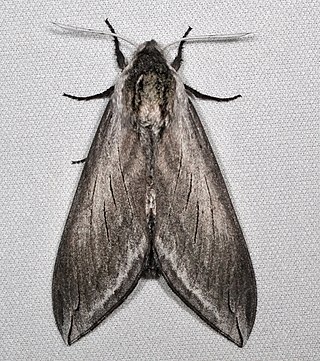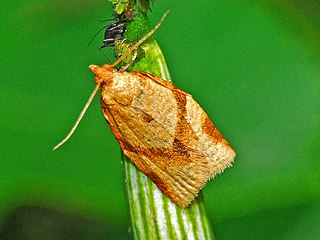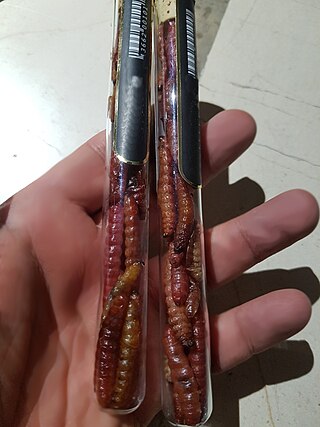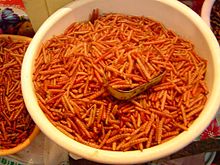
Mezcal, sometimes spelled mescal, is a distilled alcoholic beverage made from any type of agave. The word mezcal comes from Nahuatl mexcalli, which means "oven-cooked agave", from metl and ixcalli. Traditionally the word "mezcal" has been used generally in Mexico for all agave spirits and it continues to be used for many agave spirits whether these spirits have been legally certified as "mezcal" or not.

Sphinx perelegans, commonly known as the elegant sphinx, is a species of hawkmoth described by Henry Edwards in 1874. It is a large gray moth native to western North America.

A mezcal worm is an insect larva found in some types of mezcal produced in Oaxaca, Mexico. The larva is a red maguey worm, the caterpillar of the Comadia redtenbacheri moth, usually called chinicuil or gusano rojo. The red worm is typically considered tastier than a white maguey worm.

Clepsis consimilana, the privet tortrix, is a moth of the family Tortricidae.
Stigmella atrata is a moth of the family Nepticulidae. It is endemic to New Zealand and has been observed on the North Island, South Island and Stewart Island. The larvae of this species are leaf miners of Brachyglottis elaeagnifolia and Brachyglottis rotundifolia and have been recorded in April, May, July and September. Larvae pupate on the ground in a cocoon. Adults have been observed on the wing in January, February, November and December. It has been hypothesised that there is probably only one generation per year.

Stigmella fulva is a moth of the family Nepticulidae. It is endemic to New Zealand and has been observed in the North Island around Mount Taranaki, in the South Island and at Stewart Island. The species' eggs are laid singly but a considerable number may be deposited on the upper surface of one leaf. The incubation period can last from a week to a month depending on climatic conditions. The larvae mine the leaves of their host plants which are all in the genus Olearia. Larvae have been recorded in all months except January, February and June. The cocoon is brown and spun amongst the leaf litter under its host plant. The pupal period has been shown to range from 21 days to 79 days, again depending on climatic conditions. Adults have been observed on the wing January until March and August to December. They are active in the sun about their larval food plant.

Stigmella hoheriae is a species of moth of the family Nepticulidae. This day flying moth is found in New Zealand in both the North and South Islands. It inhabits native forest. Eggs are laid on the surface of a still growing leaf of a host plant. Larvae feed on Hoheria species such as Hoheria glabrata, Hoheria populnea, Hoheria sexstylosa and Hoheria angustifolia and have been recorded from February to August. The larvae of S. hoheriae are leaf miners. Their mines create blotches on the host plant leaves. S. hoheriae larvae pupate in a silk cocoon on the ground at the base of their food plant. Adult moths have been observed on the wing in February and from July to December. This species is rarely noticed as it is very small and as a result does not tend to attract attention when on the wing.
Synalocha gutierreziae is a species of moth of the family Tortricidae. It is found in the United States in Texas, Arizona and New Mexico.

Ichneutica arotis is a moth of the family Noctuidae. It is endemic to New Zealand. This species is found throughout the North and South Islands but has yet to be recorded on Stewart Island. I. arotis is variable in appearance and have been described as having a "northern dark form", a "typical" form and a "swamp" form. Robert Hoare hypothesised that this species may be in the process of evolving into several distinct species. However, as these forms show no difference in antennae or genitalia so, as at 2019, they are not regarded as separate species. Larval hosts include species in the genera Cortaderia and Schoenus as well as Phormium tenax. The caterpillar feeds at night and rests in during the day amongst dead flax leaves. It pupates in a loose cocoon either hidden at the base of a stem of flax or on the ground. The adults of this species is on the wing from September to April. In the North Island there have also been records of adults being on the wing in June to August.
Eupinivora ponderosae is a species of moth of the family Tortricidae. It is found in the montane regions of the western United States from Nevada, Utah, Wyoming and Colorado, south to Arizona and New Mexico and east to Texas. The habitat consists of conifer-dominated areas at elevations ranging from 1,700 to 2,700 meters.
Eupinivora hamartopenis is a species of moth of the family Tortricidae. It is found in Durango, Mexico.
Comadia bertholdi, the lupine borer moth, is a moth in the family Cossidae. It is found in the United States, where it has been recorded from Washington, Colorado, Wyoming, Arizona, California, Nevada and New Mexico.
Comadia henrici is a moth in the family Cossidae. It is found in North America, where it has been recorded from California, Arizona, New Mexico, Colorado, Nevada and Utah.
Comadia intrusa is a moth in the family Cossidae first described by William Barnes and Foster Hendrickson Benjamin in 1923. It is found in North America, where it has been recorded from New Mexico, Arizona and California.
Comadia suaedivora is a moth in the family Cossidae. It is found in North America, where it has been recorded from California.
Comadia subterminata is a moth in the family Cossidae first described by William Barnes and Foster Hendrickson Benjamin in 1923. It is found in North America, where it has been recorded from Arizona, Utah, Colorado and New Mexico.
Comadia alleni is a moth in the family Cossidae. It is found in North America, where it has been recorded from California.
Comadia albistrigata is a moth in the family Cossidae first described by William Barnes and James Halliday McDunnough in 1918. It is found in North America, where it has been recorded from Arizona, New Mexico and Texas.
Barchaniella inspersus is a moth in the family Cossidae. It was described by Hugo Theodor Christoph in 1887. It is found in Kyrgyzstan, Afghanistan, Kazakhstan, Uzbekistan, Turkmenistan, north-western China and south-western Mongolia.

Maguey worms are either of two species of edible caterpillars that infest maguey plants.









